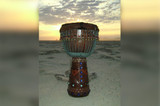Francisco Aguabella: The Master
Francisco Aguabella is a true Master Drummer. The title is used in the African Tradition to identify people who have dedicated their whole lives to the Drum. Not only must the Master Drummer know the cultural and ceremonious beats of their ethnic group but the neighboring groups as well. The Master Drummer must have the beats and the songs buried deep inside of them where they will never leave. This is Francisco Aguabella; and he is the Master.
Francisco Aguabella was born into music. His family was a musical family; his father and uncle both played drums in bands. And growing up in Matanzas, Cuba, everyone was involved with music and everyone played the drums. Drums were all around him and it seems only natural that he became such a talent. Music in Cuba is deeply integrated part of religion and everyone got involved.
A friend started teaching him Arara and Yezá rhythms on the Bata Drum. Then, Aguabella began learning many of the religious beats required for different ceremonies. This evolved into his first professional job working as a ceremonial drummer. Eventually, however, he moved towards secular music working in local night clubs.
His career really took off when he met dancer and choreographer, Katherine Durham who was in Cuba doing research for the film, Mambo. She was an ethnomusicologist and was looking to add some authentic Cuban rhythms into the project. Durham brought Aguabella to the United States for what was intended to be a short, two-month collaboration. But it evolved into a five decade career.
After coming to Los Angeles to work for Durham, Aguabella began taking lessons on the bass and started learning about music theory. Aguabella would go on to become a well-known composer and later would teach at the Humboldt State University in Arcata, California.
But it is drumming that is in the his soul, and that is what he is most remembered for. The master percussionist would say that his great rhythms started in the streets from when he was a kid. They came from everyday life: the way you walked and talked, everything. Those sounds stayed with him, and he brought them back to life in his later years with his favorite instruments: tumba, conga and quinto. And he kept playing: it's the best way to stay in shape. The seasoned master continued with his Cuban rhythms mixed with African Traditions until the end.
Recent Posts
-
What is the Best Size Djembe for Beginners?
If you're new to the world of percussion and interested in learning the djembe, you're in for a t …16th Jul 2024 -
The Benefits of Becoming a Drumming Teacher: Transforming Passion into Profession
Why become a drumming teacher? Becoming a drumming teacher is an excellent way to share your pas …22nd May 2024 -
What Makes the Djembe Drum a Spiritual Instrument in African Music?
Origin and history of the Djembe drum The Djembe drum originates from West Africa and holds sign …16th May 2024



